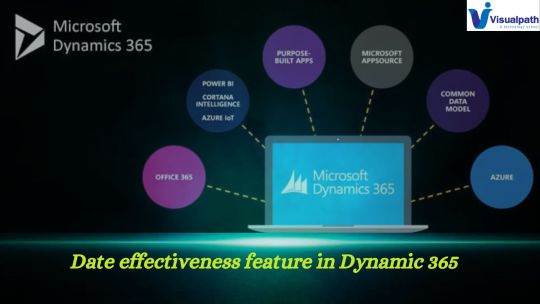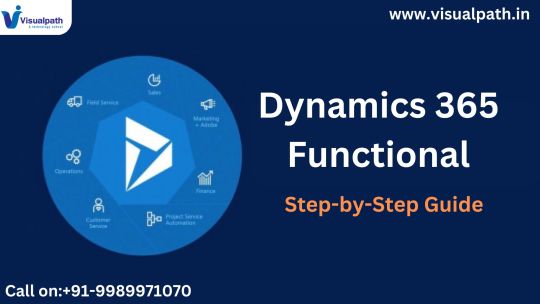#D365 Finance and Operations Online Training
Explore tagged Tumblr posts
Text
D365 Finance and Operations Online Training - Hyderabad
Using the Date Effectiveness Feature in Dynamic 365
Date Effectiveness feature in Dynamics 365 allows you to define a date range during which certain records or data within the system are effective or active. This feature is particularly useful in scenarios where you need to track changes over time, such as price updates, contract validity periods, or employee roles.
Here's how you can use the Date Effectiveness feature:
D365 Finance and Operations Training

Enable Date Effectiveness: First, ensure that the Date Effectiveness feature is enabled in your Dynamics 365 environment. This typically involves configuration settings or enabling a specific module within Dynamics 365.
Define Date Effective Entities: Identify the entities or records in Dynamics 365 that you want to make date effective. These could be custom entities you've created or standard entities provided by Dynamics 365.
D365 Finance Online Training
Configure Date Effective Fields: Within the entity settings, you'll need to specify which fields should be date effective. These are the fields whose values can change over time and need to be tracked based on effective dates.
Enter Effective Dates: When creating or updating records, you'll now have the option to specify effective dates for the data. This allows you to indicate when the information becomes valid or when it should expire.
D365 Functional Training Hyderabad
View Historical Data: With Date Effectiveness enabled, you can view historical data and track changes over time. Dynamics 365 stores the history of changes to date-effective fields, allowing you to analyse trends, audit changes, and understand the evolution of your data.
Utilize Date Effective Queries: Dynamics 365 provides capabilities to query data based on effective dates. You can create queries that retrieve records based on their validity within a specific date range, allowing you to access the relevant information at any point in time. D365 Functional Training Ameerpet
Reporting and Analysis: Leverage the historical data captured by Date Effectiveness for reporting and analysis purposes. You can generate reports, dashboards, or visualizations that showcase trends, patterns, and insights derived from the evolution of your data over time.
Visualpath offers the Best D365 Finance Online Training by real-time experts for hands-on learning. Our D365 Operations Training is available in Hyderabad and is provided to individuals globally in the USA, UK, Canada, Dubai, and Australia. Contact us at +91-9989971070.
Join us on WhatsApp: https://www.whatsapp.com/catalog/919989971070/
Visit: https://visualpath.in/dynamics-d365-finance-and-operations-course.html
#D365 Finance and Operations Training#D365 Finance and Operations Online Training#D365 Finance Online Training#D365 Operations Training#D365 Functional Training Hyderabad#Dynamics 365 Finance and Operations Training#D365 Functional Training Ameerpet
0 notes
Text
Dynamics 365 Finance Operations | Ms Dynamics 365 Training
Understanding Dynamics 365 Functional Implementation: A Step-by-Step Guide
Dynamics 365 Functional Implementation involves the deployment of finance and operations (F&O) modules to manage core business processes like supply chain, finance, and human resources. It ensures that businesses can unify their operations under one robust platform. Enrolling in a well-structured Dynamics 365 Course is crucial to understanding the intricacies of these modules.

The implementation process typically begins with assessing business needs, followed by designing a solution architecture that aligns with those requirements. Participating in D365 Functional (F&O) Online Training helps professionals gain hands-on expertise, enabling them to configure these modules to meet specific business needs. Key modules covered during training include General Ledger, Procurement, Inventory Management, and more, offering a holistic understanding of the ERP system.
Steps for a Successful Dynamics 365 Functional Implementation
Step 1: Requirements Analysis
The first step in any Dynamics 365 Functional Implementation is gathering business requirements. Engage stakeholders from various departments to understand pain points and objectives. Use tools and frameworks taught in D365 Training to conduct detailed analyses and prepare a functional requirements document.
Step 2: Solution Design and Prototyping
Designing the solution involves configuring D365 Training modules to match business needs. Prototyping is an iterative process where configurations are tested and validated. Through a Dynamics 365 Course, professionals learn how to leverage tools like Lifecycle Services (LCS) for seamless configuration and testing.
Step 3: Data Migration and Integration
Migrating legacy data into Dynamics 365 and integrating with third-party systems are critical steps. Accurate data mapping ensures data integrity and consistency. Practical knowledge gained through D365 Functional (F&O) Online Training can make this process efficient and error-free.
Step 4: User Training and Change Management
End-user training is vital for successful adoption. Enrolling your team in a Dynamics 365 Course ensures they understand how to use the system effectively. Coupled with change management strategies, training helps minimize resistance and maximizes user satisfaction.
Step 5: Deployment and Support
The final step is deploying the configured solution in the live environment. Continuous support and monitoring are essential to address any issues post-deployment. Professionals trained in D365 Functional (F&O) Online Training are well-equipped to provide on-demand support and ensure system stability.
Tips for a Smooth Implementation
Plan Thoroughly: Spend sufficient time on the planning and discovery phase to ensure smooth execution.
Leverage Training: Enroll in a comprehensive Microsoft Dynamics 365 Course to familiarize yourself with core functionalities and best practices.
Focus on User Experience: Adopt a user-centric approach to ensure the solution meets the end-users' expectations.
Continuous Testing: Test configurations rigorously during the prototyping phase to identify and resolve issues early.
Engage Experts: Seek guidance from professionals certified in D365 Functional (F&O) Online Training to ensure best practices are followed.
Conclusion
Dynamics 365 Functional Implementation is a robust solution for businesses aiming to optimize their operations and drive efficiency. With the right approach, tools, and training, organizations can maximize the potential of Dynamics 365. A comprehensive Dynamics 365 Course or D365 Functional (F&O) Online Training equips professionals with the necessary skills to execute implementations seamlessly. By following the steps outlined in this guide and leveraging these insights, businesses can achieve their ERP goals while ensuring scalability and adaptability for the future.
Visualpath is one of the Dynamics 365 Finance Operations .We provide real-time Projects with highly skilled and certified trainers with 15+ years of experience. Ms Dynamics 365 Training is especially designed for Accounting background. We are providing Demanded courses in the USA, UK, Canada, India, and Australia.Call us: - +91-9989971070.
Attend Free Demo
Call On: +91-9989971070.
Visit Blog: https://visualpathblogs.com/
WhatsApp: https://www.whatsapp.com/catalog/919989971070/
Visit:https://www.visualpath.in/online-microsoft-dynamics-365-training-in-hyderabad.html
#Microsoft Dynamics 365 Training In Hyderabad#D365 Training#Dynamics 365 Course#Ms Dynamics 365 Training#Microsoft Dynamics 365 Course#Microsoft Dynamics 365 Finance Training#Dynamics 365 Finance Operations#Dynamics 365 Finance And Operations Training#D365 Functional (F&O) Online Training
0 notes
Text
MS Dynamics D365 F&O Finance and Functional SCM online training in Hyderabad

JSV IT SOLUTIONS provides Ms Dynamics D365 Finance and Functional SCM. For enterprises, Microsoft Dynamics 365 is a Customer Relationship Management and Enterprise Resource Planning tool. This platform consists of a collection of intelligent applications that address a variety of business processes in order to provide intelligent solutions and performance optimization. Simply said, Microsoft Dynamics 365 is an ERP and CRM platform that enables enterprises to manage their internal business processes and operations using a single platform and a set of intelligent applications. As a result, these organisations will be able to enhance their operations and achieve their objectives more quickly. Furthermore, Contact Us. 9866955524
0 notes
Text
MS DynamicsD365 - Microsoft Dynamics D365
Certainly! Microsoft Dynamics 365 Finance and Operations (formerly known as Dynamics AX) is an enterprise resource planning (ERP) solution that helps organizations streamline their financial and operational processes. If you're looking for training on Dynamics 365 Finance and Operations, here are a few steps you can take:
1.Microsoft Learning Platform: Microsoft offers official training resources through the Microsoft Learning platform. You can explore their website to find various training courses, virtual labs, and certification options related to Dynamics 365 Finance and Operations. Visit the Microsoft Learning website and search for "Dynamics 365 Finance and Operations" to find relevant resources.
2.Partner Training: Many Microsoft partners offer training programs for Dynamics 365 Finance and Operations. These partners specialize in implementing and supporting Dynamics 365 solutions and often provide training to end-users and administrators. You can search for Microsoft Dynamics partners in your region and inquire about training options they offer.
3.Online Training Providers: There are several online training providers that offer courses on Dynamics 365 Finance and Operations. These platforms usually provide self-paced courses, live virtual classes, or a combination of both. Examples of popular online training providers include Udemy, LinkedIn Learning, Pluralsight, and Skillshare. You can search for courses specific to Dynamics 365 Finance and Operations on these platforms.
4.User Communities and Forums: Engaging with user communities and forums can be an excellent way to learn from experienced professionals and get practical insights about Dynamics 365 Finance and Operations. Websites like Dynamics Community and Microsoft Dynamics User Group provide discussion forums, blogs, and resources where you can connect with other users, ask questions, and learn from their experiences.
5.Microsoft Documentation and Resources: Microsoft provides extensive documentation and resources for Dynamics 365 Finance and Operations on their official website. You can access the documentation, whitepapers, videos, and tutorials to gain a deeper understanding of the product's features and functionalities. The official Microsoft Dynamics 365 documentation can be found at:https://microsoftdynamicsd365.com/ms-dynamicsd365
0 notes
Text
Record Payments and Refunds in the Payment Journal
On the Payment Journal page, you record payments that you make to vendors and refunds that you make to customers. When you post a payment journal line, the paid amount is recorded on the specified system bank account. You must then take steps to perform the actual money transfer from the related bank account.
The payment journal is a general journal that is optimized for making payments. You can quickly add lines manually, you can let Business Central suggest vendor payments, and you can apply the payment to posted documents. Even though you are making payments, you enter a positive amount in the Document Amount field. Depending on the document type for the journal line, this amount is then converted to a negative amount in the underlying transactions. This way, it's faster for you to add journal lines manually. If you prefer to enter negative amounts, you can personalize the payment journal to show the Amount field instead.
· Applying payments to invoices or credit memos
If you fill in the Applies-to Doc. No. field with the invoice or credit memo that must be paid or refunded, then the document in question is set to paid when you post the journal. This is referred to as "applied". As an alternative to applying during payment posting, you can use the Apply Vendor Entries and Apply Customer Entries page after you have made the payment posting. For more information, see, for example, Reconcile Vendor Payments with the Payment Journal or from Vendor Ledger Entries.
· Get suggested payments to vendors or employees
The Suggest Vendor Payments and Suggest Employee Payments functions can help you fill payment journal lines automatically according to vendor prioritization and due dates. For more information, see Suggest Vendor Payments. With this function, the Applies-to Doc. No. field is always filled in.
· Print checks and submit payments electronically to your bank
In addition to recording that the payment is made, you can also use the Payment Journal page to output the payment for further processing by your bank. For more information, see Make Check Payments and Make Electronic Payments.
To make payments in the payment journal
1. Choose the Search icon, enter Payment Journals, and then choose the related link.
2. Open the journal batch that is dedicated to payments.
3. If you know who to pay, fill in the fields manually. Hover over a field to read a short description.
4. To also apply the payment to the related invoice or credit memo, choose the Applies-to Doc No. field, on the Apply Vendor Entries page, select the relevant invoice or credit memo, and then choose the OK button.
Many fields, such as the Document Amount and Due Date fields, are now filled in with information from the selected document.
5. Alternatively, use the Suggest Vendor Payments function. All the applies-to information and amounts are then also entered on the journal lines. For more information, see Suggest Vendor Payments.
Messages will guide you to fill in the required fields correctly.
6. When all payment journal lines are completed, choose the Post action.
To issue a refund check
1. Choose the Search icon, enter Payment Journals, and then choose the related link.
2. In the Document Type field, select Refund.
3. In the External Document No. field, use this as a reference for the refund check (for example, return order number).
4. In the Account Type field, select Customer.
5. In the Account No. field, select the customer's account number that the refund check is being issued to.
6. In the Amount field, enter the amount to be refunded.
7. In the Bal Account Type field, select Bank Account.
8. In the Bal Account No. field, select the bank account the check will come out of.
9. In the Applies To Doc. No. field, select the documents requiring a refund.
10. When all payment journal lines are completed, choose the Post/Print action, then choose the Post and Print action, and select Yes.
For more information Click Here Contact us: 9989971070
#D365 Finance and Operations Training#D365 Finance and Operations Online Training#D365 Finance Training#D365 Operations Training
0 notes
Text
Dynamics AX vs. Dynamics 365: five Differences | Visualpath
Although they're basically exclusive variations of the identical enterprise solution, there are some key variations among the 2 ERP solutions.
1. Infrastructure
The largest distinction among Dynamics AX and Dynamics 365 is the infrastructure the structures are constructed on. When Microsoft dedicated to setting cloud era first while CEO Satya Nadella took over in 2014, they moved the Dynamics merchandise into the cloud, as well. This intended that Microsoft’s cloud service, Azure, might host D365 and every other packages from the Dynamics 365 suite of merchandise. In contrast, Dynamics AX 2012 can nevertheless be run on-premise that means that clients can host the utility on their very own servers which are bodily onsite.
For example, with an on-premise environment, a gadget administrator should write a SQL question to view information in real-time.
The procedure for code deployment to manufacturing changed into additionally modified withinside the cloud. System directors should not sell code to manufacturing on-demand, and instead, needed to agenda a deployment, which Microsoft might do at the customer’s behalf.
Despite the preliminary resistance, cloud primarily based totally infrastructure has turn out to be a customary and, oftentimes, favored approach of dealing with an ERP gadget. Creating and preserving an on-premise environment is an administrative challenge on its very own – you ought to accumulate the vital hardware, construct the community in a manner that lets in personnel around the world to get admission to it and plan for catastrophe recovery. All of this may be extraordinarily pricey and a headache to maintain. D365 Ax Technical Online Training
2. Custom Development
Another key distinction among Dynamics AX and D365 is the approach wherein custom code is written and implemented.
With any ERP implementation, there's certain to be a few software program configuration or customization had to meet precise commercial enterprise requirements. With Dynamics AX, custom improvement may be carried out the usage of the over-layering approach. D365 calls for the usage of the extensibility version in preference to over-layering. Only items which have extension factors may be customized, however if a purchaser has a want for a brand new extension, they could request it from Microsoft.
Microsoft regularly gives extensions immediately to clients or consists of them in destiny releases. When it involves upgrading, the extensibility version is fairly favored because it reasons considerably fewer compatibility problems than the over-laying approach.
3. Upgrade Model
Upgrading to a more modern model of Dynamics AX – like AX 2009 to AX 2012 – regularly calls for a brand new implementation. Many AX clients thinking about an improve locate that they first want to assess the commercial enterprise effect of the improve and enhance their commercial enterprise techniques.
Other AX clients see the want for a brand new implementation once they realise that their custom code conflicts with the code introduced with the aid of using Microsoft withinside the new software program model. In those cases, builders need to extrude and now and again completely rewrite their customizations.
With the flow to the cloud got here the possibility for Microsoft to undertake a brand new improve version, just like the improve version of cutting-edge programs purchasers are acquainted with today.
4. User Interface
A very obvious distinction among Dynamics AX and D365 is the person interface. With Dynamics AX, a person can release the utility from a laptop and carry out their paintings withinside the program. Dynamics AX has the classy of maximum ERP structures, which is, to be honest, a touch out of contact with today’s usual ERP person. Microsoft Dynamics AX Technical Training
In Dynamics AX, the homepage defaults to a place referred to as Role Centers. Here, customers can create custom queues and hyperlinks that make acting their everyday features easier.
In D365, the homepage defaults to a place referred to as Workspaces. While just like Role Centers, Workspaces are prebuilt queues, hyperlinks, lists and pics which might be associated with particular modules and safety roles.
5. Navigation
Navigational differences, eleven though minor, are really well worth noting.
A not unusual place subject throughout ERP structures is that sure displays may be released from numerous distinct locations withinside the system. In Dynamics AX, a person need to realize the menu direction to a selected display. For example, to create a brand new income order, a person can navigate to Sales and marketing > Sales orders > All income orders.
In D365, a brand new seek functionality became brought to permit customers to kind withinside the call of the display they may be seeking out and click on from the outcomes to release the page
For More Information about AWS online training Click Here
Contact: +91 9704455959
#Microsoft D365 for Finance and Operations#D365 Ax Technical Online Training#D365 Finance and Operations#D365 Finance and Operations Online Training#Microsoft Dynamics AX Technical Training
0 notes
Photo

Visualpath training institute offers D365 Finance and Operations Online Training by highly experienced professionals, providing the best D365 Finance Training with real-time project scenarios & certification help delivered. For more information Contact us@+919989971070.
#D365 Finance and Operations Training#D365 Finance and Operations Online Training#D365 Finance Training#D365 Operations Training
0 notes
Photo

D365 Finance and Operations Online Training in Hyderabad: Visualpath Training Institute offers D365 Finance and Operations training in Ameerpet Hyderabad with Industry experts. We also provide D365 Online Course. https://www.visualpath.in/dynamics-d365-finance-and-operations-course.html
0 notes
Text
Fool-Proof Methods to Get an Agile Supply Chain in 2023?
Supplychain management ERP / By Trident Information Systems
Even after two years of pandemic-driven disruptions, supply chains haven’t reached “normality” yet. In a 2021 survey of the wall street journal, most of the economists surveyed predicted supply chains to go back to normal in the mid of 2022. We have reached the end and can’t seem to get things to normal. Businesses with different and siloed Supply Chain Management Software suffered a lot. With a sudden spike in online shopping trends, they couldn’t keep up with their needs. They could not predict the disruptions and some even collapsed.
In 2023, you cannot expect things to get better either. These situations have started to become “normal”. You can continue expecting infrastructural challenges where the warehouse storage is limited for the flooded online shopping demands. And to upgrade their infrastructure, companies will have to spend too much.
Furthermore, the pandemic caused suppliers to block their supplies and even labor shortages. Climate change isn’t helping either. Climatic conditions like rain and wind impact the supply chain severely. The most impacting factor that caused the collapse of several supply chains is the lack of visibility. Siloed systems cannot provide real-time visibility with delayed most important decisions at the right moment. Those with Supply Chain Management Software manage to cope with the changes fast.
How to Make Your Supply Chain More Agile with Supply Chain Management Software
If you wish to make your supply chain agile, you must employ the latest technology that’s specifically designed to handle modern challenges. One such example is Microsoft ERP for Supply Chain. Dynamics 365 for Supply Chain Management System is reinforced with all the robust tools and functionalities that will give you all-time visibility, finance management, Business Intelligence tools, and Microsoft Cloud Azure Security. So, how to use the Top Supply Chain Management Software?
Make Sure You Have Real-Time Visibility to Make Detailed Plans
Whether you are a manufacturer, distributor, or retailer, you should focus on controlling the most parts. Your Supply Chain ERP System must provide you with complete visibility into every operation taking place. Be it inventory management, warehouse information, logistics reports, etc. this part is crucial for making detailed plans and foreseeing upcoming threats. With D365 Finance and Supply Chain Management Software, you can tap into all the information needed to beat the competition and prepare for every upcoming challenge in advance.
Inform the Customer Beforehand about the Delay
With so many options available in the market, customers lose faith very quickly if there are constant delays in their orders. It becomes worse when they are not even clarified about the duration of the delay. Many times, products are delivered from far-away places using ships, planes, and trains. Earlier, it wasn’t so easy to track where exactly the item is and if the climate doesn’t favor it, the delivery date may extend to an indefinite time. However, today our cargo’s details are processed by the insurance company, delivery company, and other services. Often, they are delivered to us automatically.
With an automatic Supply Chain Management System like D365 F&O, you can register to agreed routes and get the details about the product’s location at every stage. This is very helpful for informing the customer about the delay in delivery. You can accurately calculate the date of arrival of the product and inform the customer likewise.
Control Costs
Imported goods will cost a lot more than the base price. The delivery insurance cost, processing, and intermediate points will add to the base price and raise it to 40% or more.
Dynamics 365 Supply Chain allows controlling additional costs at every step of your complete supply chain while forming the correct costs of goods. The calculation methods will be correctly calculated based on the cost allocation policies.
If you are looking for a Supply Chain Management Software Provider, you can contact Trident Information Systems. We provide D365 Supply Chain Management Software services and are a Microsoft Dynamics 365 Gold Implementation Partner and LS Retail Diamond Partner.
#hospitality software#erp solution providers#hospitality erp software#crm in hospitality industry#hospitality management solution#hospitality management software#hospitality asset management software#crm software for hospitality industry#best hospitality management software#hospitality crm software
0 notes
Photo

Hi all, We are Conducting an Free Online Demo class On Ax(D365) FUNCTIONAL(FINANCE and T&L) by Mr. SatyaDate & Time: 10/07/2022 @9am ISTDemo Session link: https://bit.ly/3Rlm9HMFor more details +91 9704455959Visit: https://www.visualpath.in/upcoming-batches.html#online #OnlineDemo #axfunctional #D365 #finance #operations #DemoClass #newdemo #tradeandlogistics #training #freeDemo #visualpath #visualpathedu
0 notes
Text
All you need to know about Microsoft Dynamics 365 Training Service
Microsoft Dynamics 365 is a platform where all your business application that are required for your business are available.
Microsoft Dynamics 365 Training Service is the solution to provide proper Dynamics 365 Training to your team and employees. Training is the foundation on which the success of a business solution is built, and not offering enough training can have a severe knock-on effect on your business. Not only will the new system not drive the results it could and should, if your people aren’t properly engaged with the systems, they use every day their overall engagement is likely to slump too. Unengaged employees can be hugely expensive, leading to lower productivity and high employee turnover.
Good training is not a cost, but an investment; how well your employees are using your new system is critical to your business results. Luckily, there are a number of places to find great Dynamics 365 training, whatever your circumstances.
Microsoft Dynamics 365 Training Service is one of the Microsoft Dynamics 365 Solutions offered with Dynamics 365 for your business.
Microsoft Dynamics 365 Partners/Providers offer online and onsite customized training services. To further enhance performance and productivity of your D365 implementation, they also offer integrations with external systems, international roll-outs, performance tuning, BI reporting, testing, and test automation services.
With Dynamics 365 training and skills, your workforce can better help you realize the technology’s full potential and maximize your ROI.
Firms transition to new models and processes helping to ensure that your workers have the skills they need can provide you the business edge you need.
It’s true that workers of all levels can use Dynamics 365 and Power Platform to good advantage. But these sophisticated tools work even harder for you when your teams are trained to use them.
Skilling up your workforce can give you a business edge. People working across an organization from sales, marketing, service, finance, to operations and even human resources may have great communication and other skills, but they might not have the training to take advantage of the latest technology.
CEOs whose businesses provide more advanced upskilling programs—a clear commitment to developing employees’ capabilities and advancing their technical, soft, and digital skills—” cite improved engagement, innovation and ability to attract and retain talent.” By encouraging and supporting Dynamics 365 training, you can help increase your company’s ROI and its success in today’s uncertain business world.
Another benefit of Training is that you might just increase employee satisfaction when you encourage and support more training. Learning is a necessity in today’s world. Plus, it contributes to a sense of job satisfaction and helps boost employee confidence. When members of your team earn certifications in Dynamics 365, they can make a greater impact—not only on their careers but also on your company’s success.
The module Training Organization helps you organize training measures - from the selection of internal and external coaches, to the administration of participants, right through to the printing of certificates.
2 Types of Training are:
1. Classroom Training - Traditional way of training up your team is to learn from a real live expert. Instructor-led, classroom-based training can give your employees hands-on product experience, with the added benefit of having a specially trained expert on hand to answer questions. Classroom training often features group activities and discussions, which can also be useful for getting the skills learned in training to stick.
2. Online Training - training option is e-learning. E-learning offers a huge number of benefits, including reduced costs and expenses, and the convenience of learning in your own time.
“With Dynamics 365 training and skills, your workforce can better help you realize the technology’s full potential and maximize your ROI.”
#microsoft dynamics 365#microsoft dynamics 365 training services#training services#business#benefits#classroom training#online training
0 notes
Photo

MS Dynamics D365 CRM, Finance and Operation Best Online training in Hyderabad Enroll now 9395190232 (at Hyderabad High-tech City) https://www.instagram.com/p/CDwSv5PnhpA/?igshid=1iqbtx0bidbb
0 notes
Text
Transfer customizations between environments using solution export and import - Visualpath
Dynamics 365 is highly customizable. You can use its online tools to modify or create fields, entities, business processes, and more. Usually, you'll do your customization work on a sandbox environment, test them, and then transfer the final customizations to your production environments when they're ready. Best practices recommend that you proceed as follows:
1. Create a copy of your current production environment onto a sandbox environment where you can work without affecting your ongoing operations.
2. Create a new managed solution on the sandbox and implement your customizations there. This lets you add customizations without affecting the underlying system, and you can revert your customizations at any time by removing the solution.
3. Test the customized solution on your sandbox until you've confirmed it's working correctly.
4. Export the custom solution from your sandbox and then Import it on your production environment.
5. For general information about creating and working with solutions, see the links in the previous procedure and also the Solutions overview. For a full example procedure, see the following sections.
Example procedure part 1: Create a custom solution
· In this exercise, you'll create a new solution and add a simple customization to it. This will provide a simple custom solution that you can use to export and and transfer to a new environment later in this topic. If you already have a custom solution to work with, then you can skip ahead to Part 2.
To create a custom solution:
Sign in to the environment where you will develop your custom solution.
· Open the Settings menu at the top of the page and select Advanced settings. The advanced-settings area then opens in a new browser tab. Note that this area uses a horizontal navigator at the top of the page instead of a side navigator.
· Navigate to Settings > Customization > Solutions. A list of existing solutions opens.
· Select New on the command bar to create a new solution.
· A new Power Apps window opens. Provide a Display name, Name, Publisher, and Version and then select Save on the command bar to save your solution.
· For this example, we're going to copy an existing entity and then customize it, so open the Add Existing drop-down list and select Entity. A dialog opens, showing all the available entities. Here you can add any number of entities to your new solution. For this example, just select the Marketing form check box and then select OK to add it to your solution. You're now asked to choose which aspects of the selected entity you'd like to include. In this case, we want to include everything related to marketing forms, so select the Add all assets check box and then select Finish. If your selected entity requires additional components, then you'll be asked whether to include them. Select Yes, include required components and then select OK. You now return to your new solution, which now includes all of the entities and related components that you selected to include. In side panel, expand Entities to see the entities you added, and then expand the Marketing form entity and select Fields. For this example, we'll customize the Marketing form entity by adding a new field. Select New to create a new field and enter a Display Name. Leave the other settings at the default values (we'll allow this to be a text field). When you're done making all the required settings, select Save and close on the command bar.
· You now return to the Power Apps window where you're setting up the new solution. Select Publish All Customizations to make your new field available to the app.
· In the side panel of the Power Apps window, go to Components > Entities > Marketing form > Forms. We need to add our new custom field to a form to make it visible to users in the app.
· Open the from named Information with a Form type of Main by selecting its name. This is the form that users see when they create or open a marketing-form record.
· A new Power Apps window opens showing your selected form setup. In the central pane of this window, scroll down to the Summary section. Then drag your new custom field from the Field explorer panel to the General information section under the Summary. Select Save and close on the ribbon.
· You now return to the Power Apps window where you're setting up the new solution. Select Publish All Customizations to make your customized form available to the app.
· When publishing is complete, close the Power Apps window.
· If you'd like to confirm your changes, you can go to the Marketing app, open a marketing form record and look for your new field on the Summary tab.
Example procedure part 2: Export a solution
· When you're done customizing your solution and ready to move it to another environment, the next thing you must do is export the custom solution. Here's how:
· If you're not already there after the last exercise, go to the advanced-settings area by opening the Settings menu at the top of the page and then select Advanced settings.
· Navigate to Settings > Customizations > Solutions.
· Select the check box for the solution you want to export, and then select Export on the command bar.
· The system now reminds you that only published changes will be exported. If you followed the procedure in the previous section, then you should already have published everything, but if you're not sure, you can publish now. When you're ready to continue, select Next.
· You can now choose to include various system settings in the export. System settings will be applied permanently on the destination environment, and will remain there even if you later remove the solution. Normally, you shouldn't include any system settings, and if you are just doing this procedure as an exercise, then don't select any of these check boxes now. Select Next to continue. The solution now downloads as a zip file named after the solution name.
Example procedure part 3: Import a solution
· After exporting the custom solution from the source environment, you're ready to import the solution to the destination environment, which will add it's customizations to that environment and also make it easy for you to remove them again if needed (though any imported system settings will remain if you chose to include them in your exported solution).
To import a solution:
· Sign in to the environment where you will import your custom solution.
· Open the Settings menu at the top of the page and select Advanced settings. The advanced-settings area then opens in a new browser tab. Note that this area uses a horizontal navigator at the top of the page instead of a side navigator.
· Navigate to Settings > Customization > Solutions. A list of existing solutions opens.
· Select Import to begin importing the selected solution. A progress bar opens in a pop-up window, which closes automatically when the import is done. Then the import dialog updates to show the result. Select Close to close the import dialog.
· To confirm the import, go to the Marketing app, open a marketing form record and look for the new customized field on the Summary tab.
For more information Click Here Contact us: 9989971070
#D365 Ax Technical Online Training#D365 Finance and Operations Online Training#Microsoft Dynamics AX Technical Training#Microsoft Dynamics AX Training
0 notes
Photo

Ms Dynamics D365 AX Finance and operations Best online training in Hyderabad Enroll now 9395190232 (at Hyderabad High-tech City) https://www.instagram.com/p/B_xWZtZH9SF/?igshid=m9oo0tto6p2d
0 notes
Photo

Visualpath training institute is offering one of the best D365 Finance Training by highly experienced and certified professionals with an interactive session with interview QA’s. For more information Contact us@+919989971070.
#D365 Finance and Operations Training#D365 Finance and Operations Online Training#D365 Finance Training#D365 Operations Training
0 notes